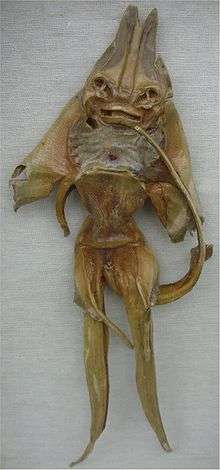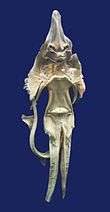Jenny Haniver
A Jenny Haniver is the carcass of a ray or a skate that has been modified by hand then dried, resulting in a mummified specimen intended to resemble a fanciful fictional creature, such as a demon or dragon.[1][2][3]

Name
One suggestion for the origin of the term was the French phrase jeune d'Anvers ("youth of Antwerp"). British sailors "cockneyed" this description into the personal name "Jenny Hanvers". They are also widely known as "Jenny Haviers"[1][3].
History
Jenny Hanivers have been created to look like devils, angels and dragons. Some writers have suggested the sea monk may have been a Jenny Haniver.[1]
The earliest known picture of Jenny Haniver appeared in Konrad Gesner's Historia Animalium vol. IV in 1558. Gesner warned that these were merely disfigured rays and should not be believed to be miniature dragons or monsters, which was a popular misconception at the time.[3][4]
The most common misconception was that Jenny Hanivers were basilisks. As basilisks were creatures that killed with merely a glance, no one could claim to know what one looks like. For this reason it was easy to pass off Jenny Hanivers as these creatures, which were still widely feared in the 16th century.[5]
In Veracruz, Jenny Hanivers are considered to have magical powers and are employed by curanderos in their rituals.[6] This tradition is similar to one in Japan, where fake taxidermy ningyo (similar to Fiji mermaids) were produced and kept in temples.
Gallery
See also
- The Jenny Haniver is an airship in the Mortal Engines Quartet series of novels by Philip Reeve, and a boat in one of its prequels, A Web of Air.
- The Bermuda Depths, a 1978 fantasy film which starred Leigh McCloskey and Connie Sellecca, featured Sellecca as a mysterious character named "Jenny Haniver."
References
| Wikimedia Commons has media related to Jenny Haniver. |
- "Journal of the Bizarre". Retrieved 15 November 2014.
- Roger G-S. "Roles, Rules, and Rolls: Monster Monday: Jenny Haniver, Sea Clergy, and Morkoths". Retrieved 15 November 2014.
- "jenny hanivers - Poems Underwater". Retrieved 15 November 2014.
- "Jenny Haniver". Wondercabinet. Retrieved 15 November 2014.
- Peter Dance, Animal Fakes and Frauds
- "FOTOS El diablo, un pez para la magia negra - El Universal Veracruz" (in Spanish). Archived from the original on 28 May 2014. Retrieved 15 November 2014.
.jpg)

